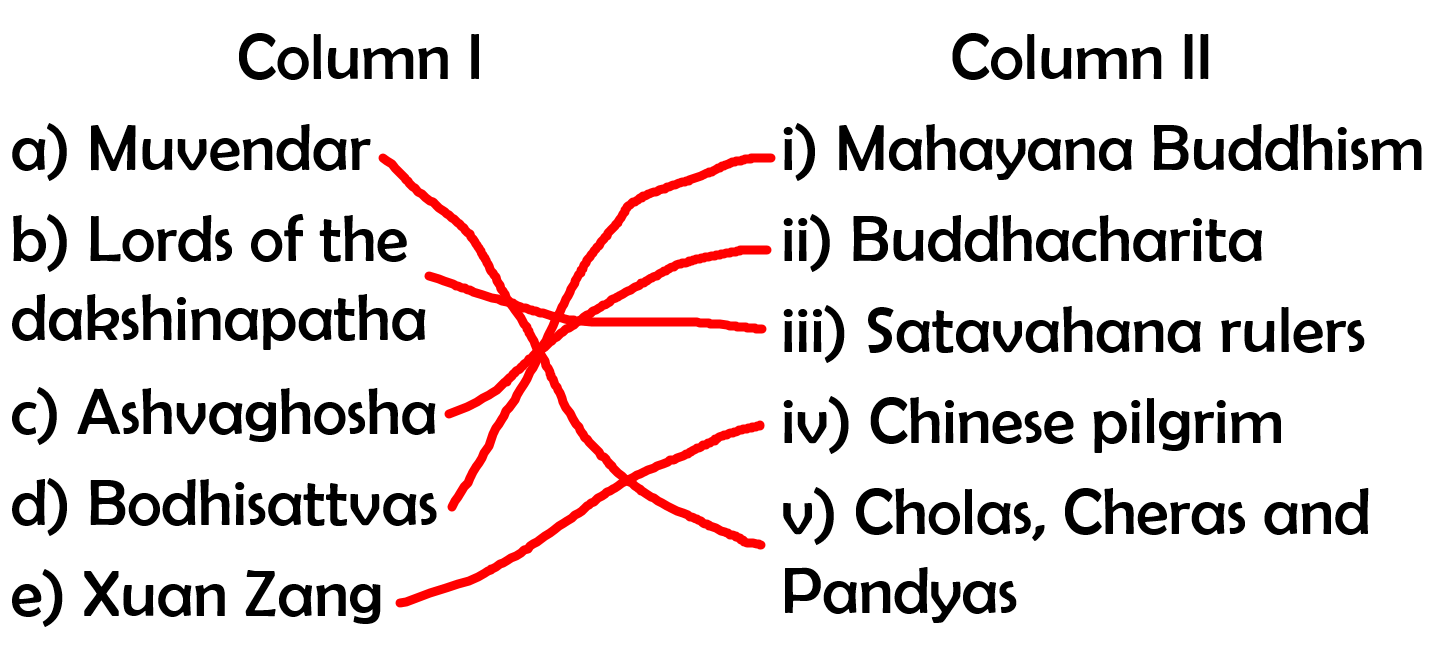Chapter 10 - Traders, Kings and Pilgrims
Question 1: Match the following:

Question 2: Why did kings want to control the Silk Route?
Answer: Kings wanted to control the Silk Route because they could benefit from taxes, tributes and gifts that were brought by traders and the people along the route.
Question 3: What kinds of evidence do historians use to find out about trade and trade routes?
Answer: The historians use the following evidences to find out about trade and trade routes:
• Northern Black Polished Ware is fine pottery, especially bowls and plates, were found from several archaeological sites throughout the subcontinent.
• Traders may have carried them from the places where they were made, to sell them at other places. South India was famous for gold, spices, especially pepper, and precious stones.
• Pepper was particularly valued in the Roman Empire, so much so that it was known as black gold. So, traders carried many of these goods to Rome in ships, across the sea, and by land in caravans. There must have been quite a lot of trade as many Roman gold coins have been found in south India.
• Traders explored several sea routes. Some of these followed the coasts. There were others across the Arabian Sea and the Bay of Bengal, where sailors took advantage of the monsoon winds to cross the seas more quickly.
• So, if they wanted to reach the western coast of the subcontinent from East Africa or Arabia, they chose to sail with the south-west monsoon. And sturdy ships had to be built for these long journeys.
Question 4: What were the main features of Bhakti?
Answer:
• Bhakti is generally understood as a person’s devotion to his or her chosen deity. Anybody, whether rich or poor, belonging to the so-called ‘high’ or ‘low’ castes, man or woman, could follow the path of Bhakti.
• The idea of Bhakti is present in the Bhagavad Gita, a sacred book of the Hindus, which is included in the Mahabharata. In this Krishna the God, asks Arjuna, his devotee and friend, to abandon all dharmas and take refuge in him, as only he can set Arjuna free from every evil.
• This form of worship gradually spread to different parts of the country. Those who followed the system of Bhakti emphasised devotion and individual worship of a god or goddess, rather than the performance of elaborate sacrifices.
• According to this system of belief, if a devotee worships the chosen deity with a pure heart, the deity will appear in the form in which he or she may desire. So, the deity could be thought of as a human being, lion, tree or any other form. Once this idea gained acceptance, artists made beautiful images of these deities.
• Deities who were worshipped through Bhakti included Shiva, Vishnu and goddesses such as Durga. This form of worship became an important feature of Hinduism.
Question 5: Discuss the reasons why the Chinese pilgrims came to India?
Answer: The Chinese pilgrims (Fa-Xian, Xuan Zang and I-Qing) came to India to visit places associated with the life and teachings of the Buddha as well as famous monasteries. They had in Buddhist religious books also. They carried some books back with them.
Question 6: Why do you think ordinary people were attracted to Bhakti?
Answer:
• Ordinary people were attracted to Bhakti because Bhakti-saint used the language of people, which they could understand easily.
• The saints emphasized the worship of certain deities, which became a central feature of later Hinduism, gained in importance.
• These deities included Shiva, Vishnu and goddesses such as Durga. Bhakti is generally understood as a person’s devotion to his or her chosen deity.
• Anybody, whether rich or poor, belonging to the so called ‘high’ or ‘low’ castes, man or woman, could follow the path of Bhakti.
• They stressed on simple ways for Moksha or salvation, the last aim of life.
Question 7: List five things that you buy from the market. Which of these are made in the city/village in which you live and which are brought by traders from other areas?
Answer:
List of things that we buy from the market:
a) Things made in city
• Steel pots and pans
• Plastic baskets
• Cloth printed with brilliant floral designs
• Clockwork or electronic toys
• Radio and Television sets
b) Things made in village
• Clay pots made by village potter
• Leather shoes and Chappals manufactured by village shoemaker
• Wooden toys and articles manufactured by village carpenter
• Iron and metal tools and articles made by village blacksmith
• Ring and other ornaments made by village goldsmith.
c) Things brought by our traders
• Black pepper in carts
• Gems and gold from the southern India
• Sandalwood collected from the forests
Question 8: There are several major pilgrimages performed by people in India today. Find out about anyone of them and write a short description. [Hint: Who can go on the pilgrimage - men, women or children? How long does it take? How do people travel? What do they take with them? What do they do when they reach the holy place? Do they bring anything back with them?]
Answer: Vaishno Devi is Hindu temple which is located in Katra, Jammu and Kashmir, India. Anyone can go on the pilgrimage, it can be either men, women or children. They reach Katra by train or aeroplane or bus or by their own transport. Then to visit Devi Maa temple they have to travel on foot or horse or helicopter. They take flower garland, coconut, chunari, prasad etc to offer to Mata Vaishno Devi. They then worship God Devi and offer the prasad. After the worship, the priest give them prasad and they eat it.
No comments:
Post a Comment